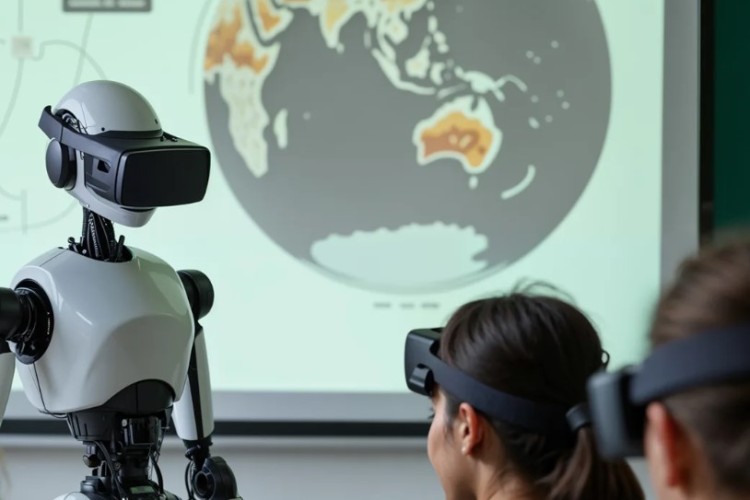AI in education: This is not my domain—neither by training nor by profession. I have never built machines, nor have I ever spoken in code. I have spent over two decades observing students think, stumble, reflect, and grow. Today, I see many of them bypass the very struggle that once shaped the process of learning. In the age of Artificial Intelligence, speed has become a virtue. A single prompt now generates a full paper; a query becomes an instant answer.
But pause for a moment—are we, in our haste to think fast, forgetting the value of thinking slow? Not just facts, but the effort to understand, the humility to question, and the values that elevate knowledge beyond data? This is not nostalgia. The real question is: what becomes of the human when the machine becomes the mirror?
READ | Trump’s Iran strike could erode US influence, aid China and Russia
When thought is outsourced
What troubles me is not that AI can solve problems quickly. It is that students are beginning to outsource thought itself. It is increasingly seen as acceptable—no longer unethical—to feed a term paper into a chatbot. The learning journey, once marked by struggle and introspection, is being replaced by shortcuts. In this digital sprint, machines run without limbs, without conscience, and without pause. But we, as humans, carry the burden of ethics. We must ask: in our pursuit of speed, what are we leaving behind?
French philosopher Michel Foucault warned that knowledge is always intertwined with power. Today, AI represents a new regime of power—a predictive force that determines what we see, recommend, and choose. In education, personalised learning is increasingly steered by algorithms. But who writes these algorithms? Who decides the path a student takes? With AI at the helm, there is a real risk of reducing students to data points—pre-categorised, depersonalised, and subjected to what Foucault would describe as the ‘panoptic gaze’. This is not just about efficiency—it is about control.
The illusion of meaning
The UNESCO Recommendation on the Ethics of AI (2021) rightly emphasises autonomy, fairness, and inclusivity. Yet these ideals are undermined when algorithms reflect the unconscious biases of their creators, reinforcing historical inequalities and marginalising dissent.
If algorithms are a form of language, we must heed Noam Chomsky’s reminder that language is more than a tool—it is a symbol of our innate creative potential. Machines may produce grammatically correct sentences, but they do not comprehend meaning. They mimic—but they do not muse. The CEPE/IACAP editorial captures this well: AI lacks semantic depth; it offers statistical imitation. The danger lies in students mistaking this imitation for insight. Writing risks becoming prompt engineering, rather than an exercise in thought.
As educators, our role is not limited to policing plagiarism. It is a moral imperative to reignite the desire to think.
AI in education: Speed vs freedom
There is no doubt that AI offers civilisation immense benefits—enhancing diagnostics, streamlining logistics, widening access to public services. In public policy, AI aids climate analysis, healthcare access, and disaster response. But faster is not always better.
Amartya Sen, in Development as Freedom, argued that development must expand human freedoms, not just boost output. By this measure, we must ask: is AI empowering individuals—or merely creating more efficient subjects for a digital regime?
A global review by UNESCO reveals a telling trend—only 25% of national AI strategies mention gender equity, and even fewer address environmental ethics. In fragile regions—economically, socially, or geopolitically—AI can be a tool for upliftment. But if its intent is misguided, it can just as easily become a quiet agent of surveillance and control.
Vanishing line between help and handover
For educators, the question grows more urgent: in a world where machines generate essays, poems, and legal briefs in seconds, what becomes of originality? Can authenticity still be assessed when the boundary between assistance and authorship has blurred? This is not moral panic. It is a systemic dilemma.
AI will grow smarter. Students will grow smarter at using it. But this ‘smartness’ may not lead to deeper learning—it may merely enhance performance. Eventually, ethics risks becoming collateral damage in the race for grades.
Should we ban AI? Certainly not. But we must redesign education to teach ethics by design. We must embed critical thinking in every interaction with AI, turning the tool into an object of reflection, not deception.
A culture, not a checklist
AI is not our enemy. It is a reflection of our ideals, our uncertainties, and our ambitions. It becomes dangerous only when we stop questioning it. As philosopher Luciano Floridi reminds us, the “ethics of being” demand that we focus not on what machines can do, but on what we should become. Our task is to build machines that remind us of our responsibilities—not ones that replace them.
The ethics of AI cannot be reduced to a checklist. It must be a culture—a continuous conversation. This dialogue must accompany every dataset, every design, and every deployment. Students must not run this digital race blindly. They must ask: why are we running? Where are we going? And who designed the course?
It is time to pause—to think, to feel, and to choose wisely.

